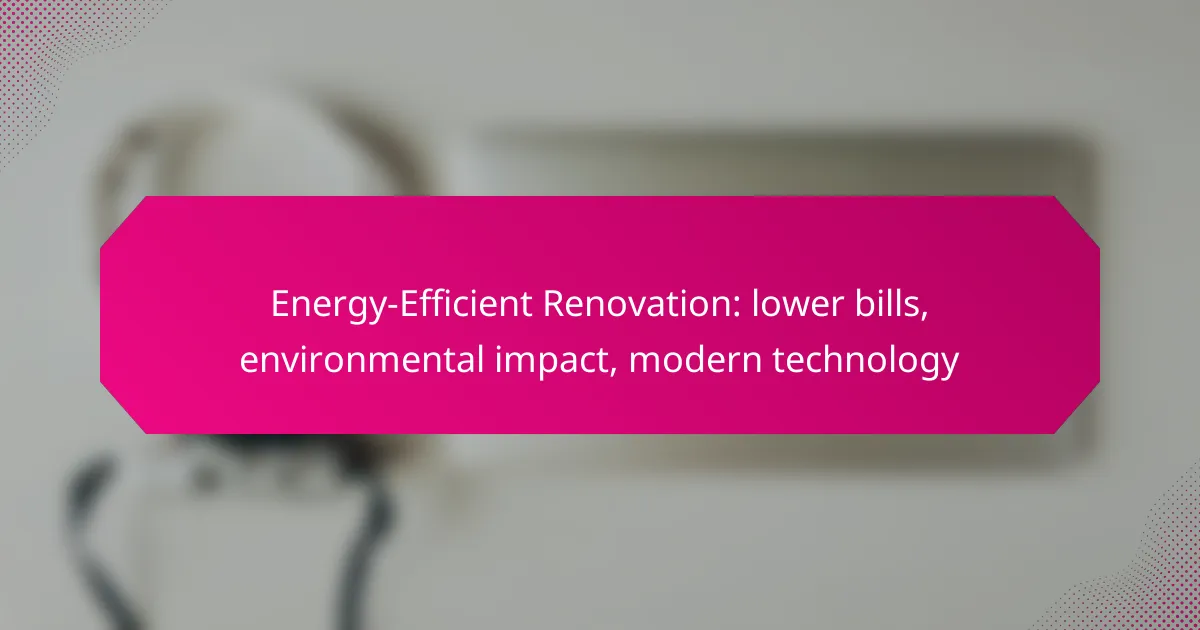Energy-efficient renovations are a smart investment for homeowners looking to lower utility bills while making a positive impact on the environment. By incorporating modern technologies such as solar panels and high-efficiency HVAC systems, these upgrades not only enhance home efficiency but also contribute to a healthier planet by reducing energy consumption and harmful emissions.
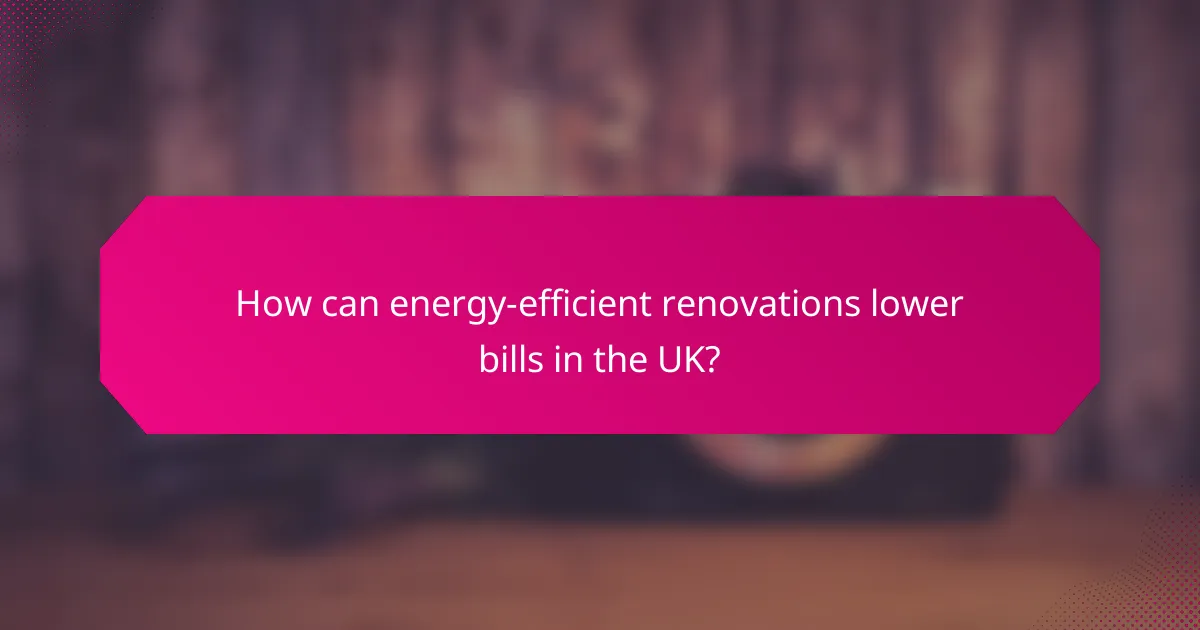
How can energy-efficient renovations lower bills in the UK?
Energy-efficient renovations can significantly reduce utility bills in the UK by minimizing energy consumption and enhancing overall home efficiency. By implementing various improvements, homeowners can expect lower heating and electricity costs while contributing to environmental sustainability.
Insulation improvements
Enhancing insulation is one of the most effective ways to lower energy bills. Proper insulation in walls, roofs, and floors can reduce heat loss during colder months, leading to less reliance on heating systems. Homeowners should consider materials like fiberglass, foam, or cellulose, which can provide substantial energy savings.
In the UK, upgrading to insulation that meets or exceeds the current building regulations can yield savings of around 20-30% on heating costs. It’s essential to conduct an energy audit to identify areas needing improvement and to choose insulation that suits the specific climate and building type.
Energy-efficient appliances
Replacing old appliances with energy-efficient models can lead to significant reductions in electricity usage. Look for appliances with high energy ratings, typically labeled A++ or A+++, which consume less power while maintaining performance. Common upgrades include refrigerators, washing machines, and dishwashers.
In the UK, energy-efficient appliances can save households hundreds of pounds over their lifespan. When purchasing, consider the initial cost versus long-term savings, and check for government incentives or rebates that may be available for energy-efficient upgrades.
Smart home technology
Smart home technology can optimize energy usage by allowing homeowners to monitor and control their energy consumption. Devices such as smart thermostats, lighting systems, and energy monitors can help identify wasteful habits and adjust settings for maximum efficiency.
For instance, a smart thermostat can learn your schedule and adjust heating and cooling accordingly, potentially saving 10-15% on energy bills. Investing in smart technology not only enhances comfort but also promotes energy conservation, making it a practical choice for modern homes in the UK.

What environmental benefits do energy-efficient renovations provide?
Energy-efficient renovations significantly reduce environmental impact by lowering energy consumption and minimizing waste. These upgrades not only help in decreasing utility bills but also contribute to a healthier planet by reducing harmful emissions.
Reduced carbon footprint
Implementing energy-efficient renovations can lead to a substantial reduction in your carbon footprint. By using energy-efficient appliances, insulation, and renewable energy sources, homeowners can cut greenhouse gas emissions by a notable percentage, often in the range of 20-50% depending on the extent of the upgrades.
For example, switching to LED lighting and Energy Star-rated appliances not only lowers energy use but also decreases the demand on power plants, which are significant sources of carbon emissions. Additionally, integrating solar panels can further offset your reliance on fossil fuels.
Conservation of resources
Energy-efficient renovations promote the conservation of natural resources by reducing the overall demand for energy. Improved insulation and energy-efficient windows help maintain indoor temperatures, which means less energy is required for heating and cooling.
Moreover, these renovations often involve using sustainable materials, which can minimize waste and lower the consumption of raw materials. For instance, opting for reclaimed wood or recycled materials can significantly reduce the environmental impact associated with new construction.
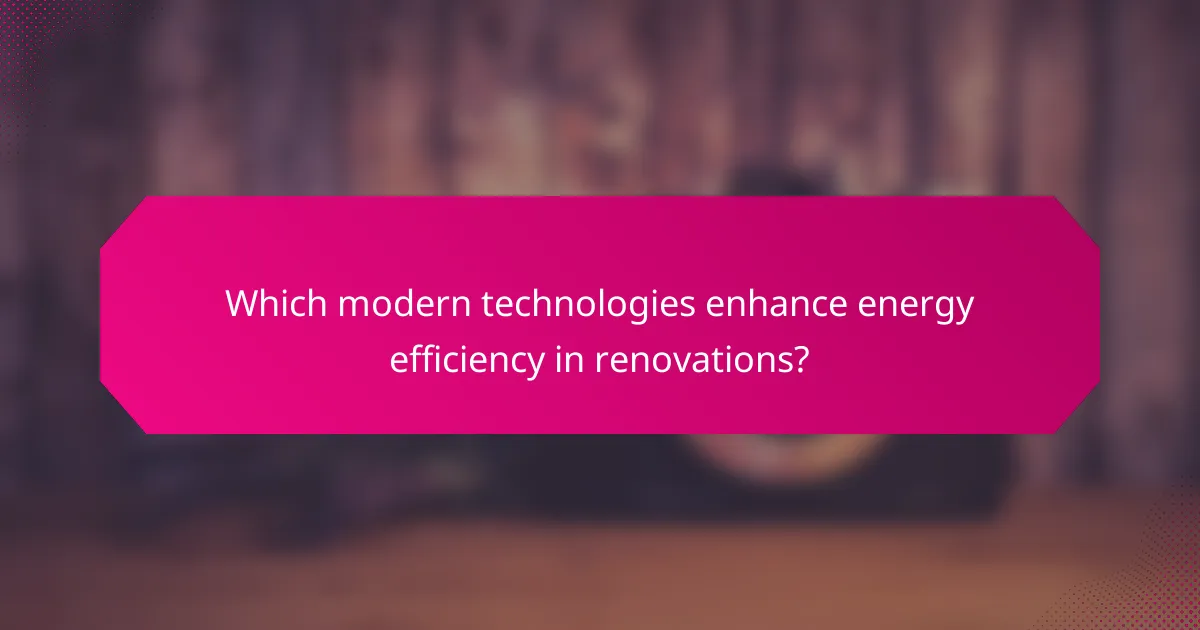
Which modern technologies enhance energy efficiency in renovations?
Modern technologies significantly enhance energy efficiency in renovations by optimizing energy use and reducing waste. Key innovations include solar panels, energy management systems, and high-efficiency HVAC systems, each offering unique benefits for lowering energy bills and minimizing environmental impact.
Solar panels
Solar panels convert sunlight into electricity, providing a renewable energy source that can power your home. By installing solar panels, homeowners can reduce reliance on grid electricity, leading to lower monthly utility bills and a smaller carbon footprint.
When considering solar panels, evaluate your roof’s orientation and shading, as these factors affect energy production. Additionally, check local incentives or rebates that can offset installation costs, which typically range from several thousand to tens of thousands of dollars depending on system size and location.
Energy management systems
Energy management systems (EMS) monitor and control energy consumption in real-time, allowing homeowners to identify inefficiencies and optimize usage. These systems can integrate with smart devices, providing insights into energy patterns and enabling automated adjustments to reduce waste.
Investing in an EMS can lead to significant savings, often reducing energy costs by 10-30%. Look for systems that offer user-friendly interfaces and compatibility with existing appliances to maximize benefits without extensive upgrades.
High-efficiency HVAC systems
High-efficiency HVAC systems use advanced technology to heat and cool spaces more effectively while consuming less energy. These systems often feature variable-speed motors and improved insulation, which enhance performance and comfort.
When upgrading to a high-efficiency HVAC system, consider models with a Seasonal Energy Efficiency Ratio (SEER) rating of 16 or higher for optimal savings. Regular maintenance is crucial to ensure these systems operate at peak efficiency, so schedule annual check-ups to avoid costly repairs and maintain energy savings.

What are the costs associated with energy-efficient renovations?
The costs of energy-efficient renovations can vary widely based on the scope of the project, materials used, and local labor rates. Homeowners should consider both the initial investment and the potential long-term savings when evaluating these renovations.
Initial investment
The initial investment for energy-efficient renovations typically includes expenses for materials, labor, and any necessary permits. For example, upgrading insulation or installing energy-efficient windows can range from a few thousand to tens of thousands of dollars, depending on the size of the home and the quality of materials chosen.
It’s essential to obtain multiple quotes from contractors to ensure competitive pricing. Additionally, consider any available rebates or incentives from local governments or utility companies that can help offset these upfront costs.
Long-term savings
Long-term savings from energy-efficient renovations often manifest through reduced utility bills and increased property value. Homeowners can expect to save anywhere from 10% to 30% on energy costs annually, depending on the improvements made, such as solar panels or high-efficiency HVAC systems.
Moreover, these renovations can enhance the resale value of a home, making it more attractive to potential buyers. It’s advisable to calculate the payback period for the investment, which can help in assessing the financial viability of the renovations over time.
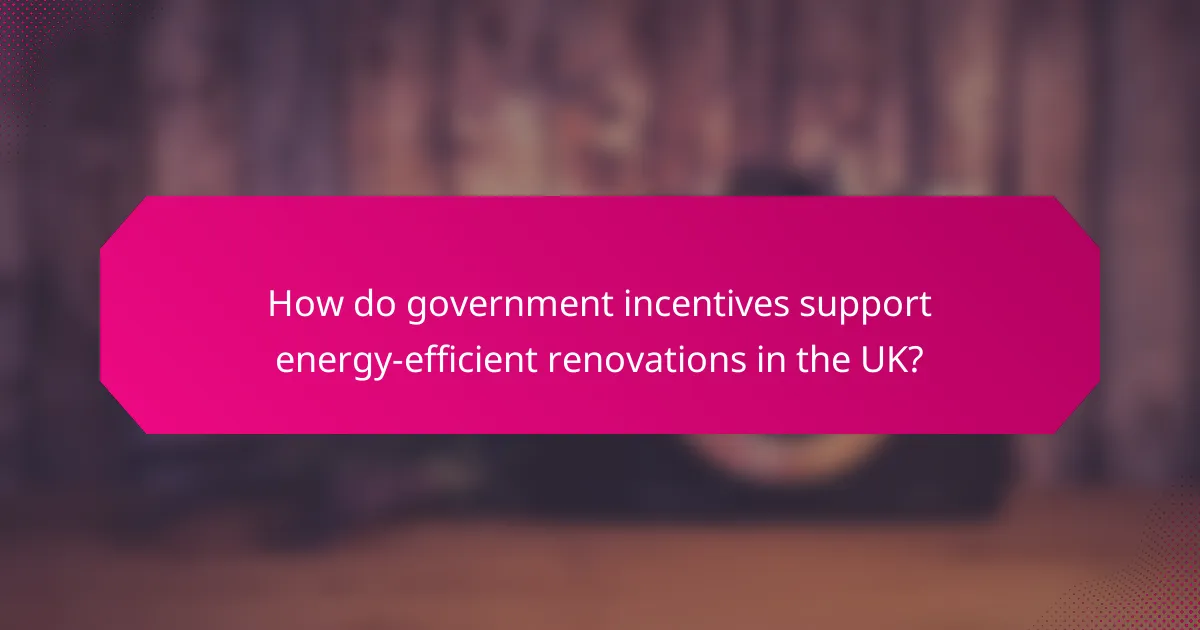
How do government incentives support energy-efficient renovations in the UK?
The UK government offers various incentives to encourage energy-efficient renovations, helping homeowners reduce costs and environmental impact. These incentives can significantly lower upfront expenses and improve the overall return on investment for energy-saving upgrades.
Grants and rebates
Grants and rebates are financial aids provided by the government to support energy-efficient home improvements. Homeowners can apply for these funds to cover a portion of the costs associated with upgrades like insulation, heating systems, and renewable energy installations.
For example, the Green Homes Grant, although recently closed, previously offered up to £5,000 for eligible renovations. Homeowners should check local council websites for any available grants or rebate programs that may assist with their renovation projects.
Tax credits
Tax credits reduce the amount of tax owed and can be a valuable incentive for homeowners investing in energy-efficient renovations. In the UK, certain energy-saving measures may qualify for tax relief, allowing homeowners to reclaim a portion of their renovation costs through their tax returns.
For instance, energy-efficient heating systems or solar panel installations may be eligible for tax credits. Homeowners should consult with a tax advisor to understand which upgrades qualify and how to properly claim these credits to maximize their financial benefits.
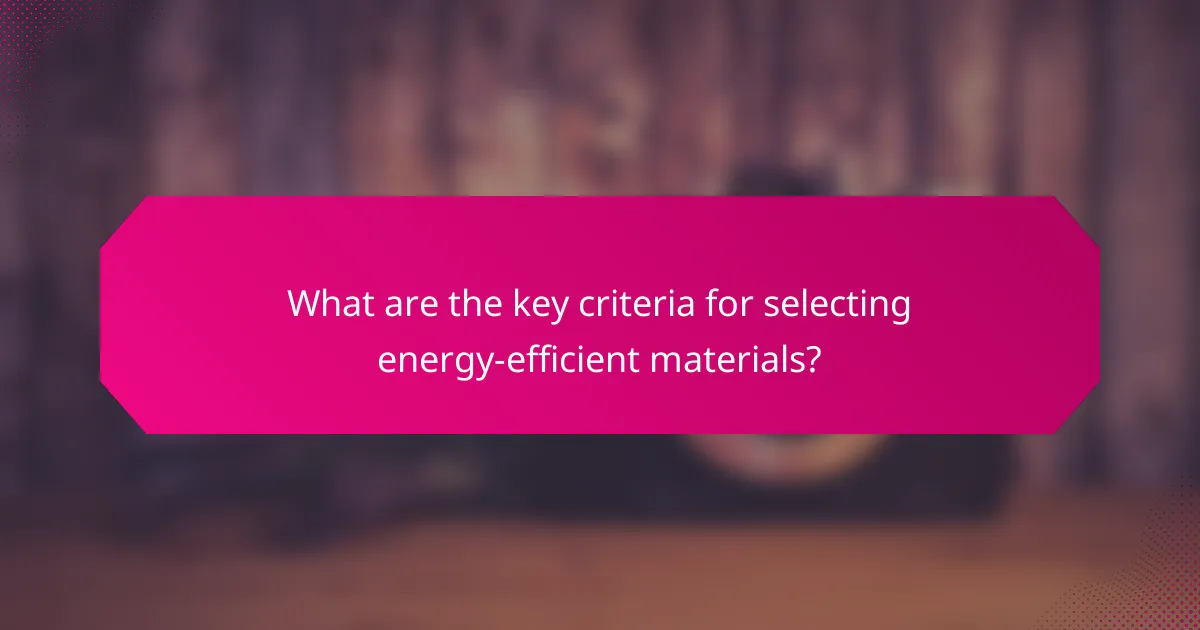
What are the key criteria for selecting energy-efficient materials?
When selecting energy-efficient materials, prioritize their energy ratings, durability, and lifespan. These criteria help ensure that the materials not only reduce energy consumption but also provide long-term value and performance.
Energy ratings
Energy ratings indicate how effectively a material or product uses energy. Look for labels such as ENERGY STAR or equivalent local certifications, which signify that the product meets specific energy efficiency standards. Higher ratings typically correlate with lower energy bills and reduced environmental impact.
For example, appliances with an ENERGY STAR label can be up to 30% more efficient than non-rated models. When considering insulation, materials with higher R-values provide better thermal resistance, helping to maintain comfortable indoor temperatures with less energy use.
Durability and lifespan
Durability and lifespan are crucial for energy-efficient materials, as longer-lasting products reduce the need for replacements and associated energy costs. Materials that withstand wear and tear can save money over time, making them a smart investment.
For instance, high-quality windows with low maintenance requirements can last several decades, while cheaper alternatives may need replacement within a decade. When evaluating materials, consider their warranty and maintenance needs to ensure they align with your long-term energy efficiency goals.
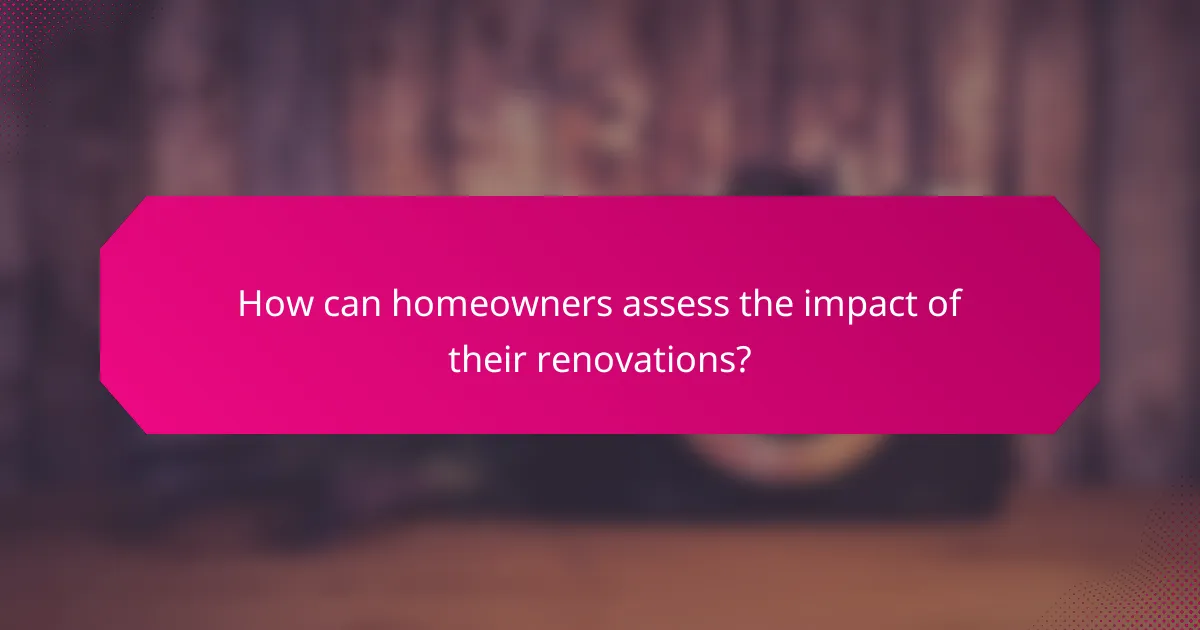
How can homeowners assess the impact of their renovations?
Homeowners can assess the impact of their renovations by conducting energy audits and comparing utility bills before and after the improvements. These methods provide valuable insights into energy efficiency gains and cost savings.
Energy audits
Energy audits are comprehensive evaluations of a home’s energy use, identifying areas where improvements can be made. A professional auditor will assess insulation, heating and cooling systems, and appliances to determine energy loss and recommend upgrades.
Homeowners can expect to pay between $100 and $500 for a thorough energy audit, depending on the home’s size and location. Many utility companies offer rebates or incentives to offset these costs, making audits more accessible.
Utility bill comparisons
Comparing utility bills before and after renovations is a straightforward way to gauge the financial impact of energy-efficient upgrades. Homeowners should track monthly energy costs over a year to account for seasonal variations.
To make a meaningful comparison, focus on similar months across different years. A reduction of 20-30% in energy bills after renovations typically indicates successful improvements. Keep in mind that external factors, such as changes in energy rates, can also influence these figures.
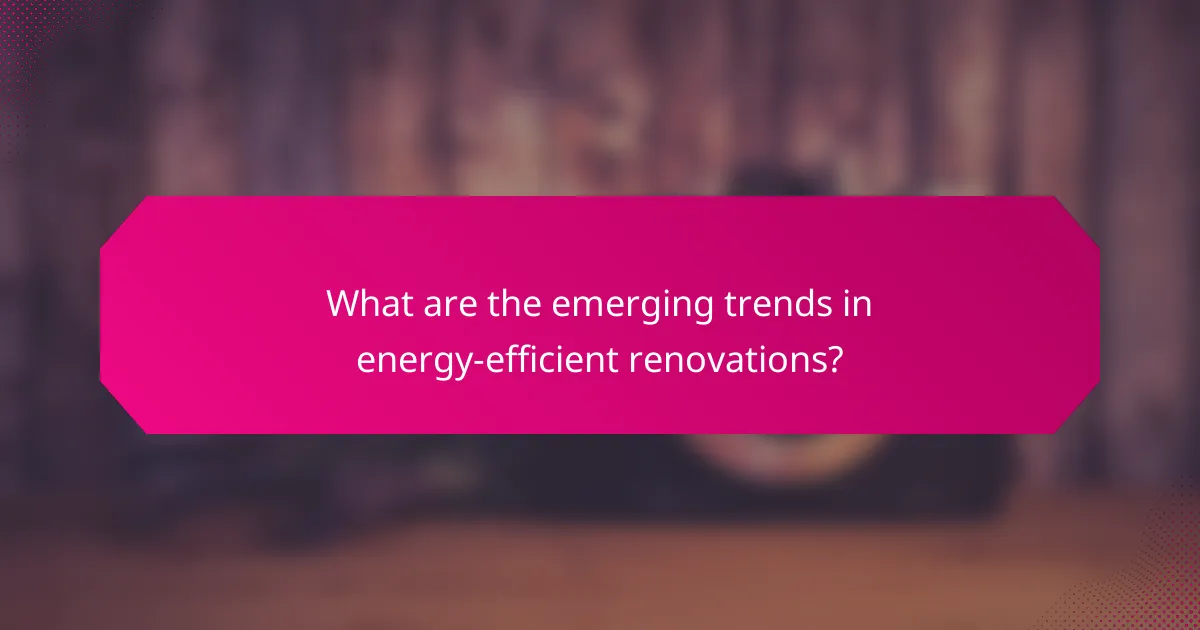
What are the emerging trends in energy-efficient renovations?
Emerging trends in energy-efficient renovations focus on integrating modern technology, sustainable materials, and innovative design to lower energy bills and reduce environmental impact. These renovations often prioritize energy efficiency, comfort, and functionality, making homes more sustainable and cost-effective.
Smart Home Technology
Smart home technology is increasingly being incorporated into energy-efficient renovations. Devices such as smart thermostats, energy monitoring systems, and automated lighting can significantly reduce energy consumption by optimizing usage based on real-time data. For example, a smart thermostat can adjust heating and cooling based on occupancy, leading to noticeable savings on utility bills.
When considering smart technology, look for systems that are compatible with existing infrastructure and offer user-friendly interfaces. Many devices can be controlled remotely via smartphones, enhancing convenience and efficiency.
Sustainable Materials
The use of sustainable materials is a key trend in energy-efficient renovations. Materials such as reclaimed wood, bamboo, and recycled metal not only reduce environmental impact but also enhance the aesthetic appeal of a home. Choosing locally sourced materials can further minimize transportation emissions and support local economies.
When selecting materials, consider their lifecycle impact, including energy used in production and disposal. Certifications like LEED or FSC can guide you toward environmentally responsible choices.
Energy-Efficient Windows and Insulation
Upgrading to energy-efficient windows and improving insulation are critical components of energy-efficient renovations. High-performance windows can reduce heat loss and gain, while advanced insulation materials can minimize energy transfer, keeping homes comfortable year-round. This can lead to savings of 10-30% on heating and cooling costs.
When replacing windows, look for those with low U-values and high solar heat gain coefficients. For insulation, consider options like spray foam or cellulose, which offer superior thermal performance. Always ensure proper installation to maximize benefits.
Renewable Energy Integration
Integrating renewable energy sources, such as solar panels or wind turbines, is becoming more common in energy-efficient renovations. These systems can significantly reduce reliance on traditional energy sources, leading to lower utility bills and a smaller carbon footprint. Many homeowners are finding that the initial investment pays off through long-term savings and potential tax incentives.
Before installation, assess your property’s solar potential or wind resources and consult with professionals to determine the best system for your needs. Local regulations and incentives can also influence the feasibility and cost-effectiveness of renewable energy solutions.
